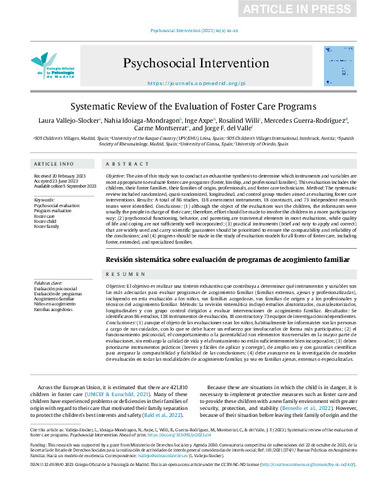Systematic Review of the Evaluation of Foster Care Programs
Fecha de publicación:
Versión del editor:
Citación:
Resumen:
Objetive: The aim of this study was to conduct an exhaustive synthesis to determine which instruments and variables are most appropriate to evaluate foster care programs (foster, kinship, and professional families). This evaluation includes the children, their foster families, their families of origin, professionals, and foster care technicians. Method: The systematic review included randomized, quasi-randomized, longitudinal, and control group studies aimed at evaluating foster care interventions. Results: A total of 86 studies, 138 assessment instruments, 18 constructs, and 73 independent research teams were identified. Conclusions: (1) although the object of the evaluations was the children, the informants were usually the people in charge of their care; therefore, effort should be made to involve the children in a more participatory way; (2) psychosocial functioning, behavior, and parenting are transversal elements in most evaluations, while quality of life and coping are not sufficiently well incorporated; (3) practical instruments (brief and easy to apply and correct) that are widely used and carry scientific guarantees should be prioritized to ensure the comparability and reliability of the conclusions; and (4) progress should be made in the study of evaluation models for all forms of foster care, including foster, extended, and specialized families.
Objetive: The aim of this study was to conduct an exhaustive synthesis to determine which instruments and variables are most appropriate to evaluate foster care programs (foster, kinship, and professional families). This evaluation includes the children, their foster families, their families of origin, professionals, and foster care technicians. Method: The systematic review included randomized, quasi-randomized, longitudinal, and control group studies aimed at evaluating foster care interventions. Results: A total of 86 studies, 138 assessment instruments, 18 constructs, and 73 independent research teams were identified. Conclusions: (1) although the object of the evaluations was the children, the informants were usually the people in charge of their care; therefore, effort should be made to involve the children in a more participatory way; (2) psychosocial functioning, behavior, and parenting are transversal elements in most evaluations, while quality of life and coping are not sufficiently well incorporated; (3) practical instruments (brief and easy to apply and correct) that are widely used and carry scientific guarantees should be prioritized to ensure the comparability and reliability of the conclusions; and (4) progress should be made in the study of evaluation models for all forms of foster care, including foster, extended, and specialized families.
ISSN:
DOI:
Patrocinado por:
This research was supported by a grant from Ministerio de Derechos Sociales y Agenda 2030. Convocatoria competitiva de subvenciones del 22 de octubre de 2021, de la Secretaría de Estado de Derechos Sociales para la realización de actividades de interés general consideradas de interés social; Ref. 101/2021/274/1/ Buenas Prácticas en Acogimiento Familiar. Hacia un modelo de excelencia
Colecciones
- Artículos [37544]
- Investigaciones y Documentos OpenAIRE [8416]
- Psicología [1481]
Ficheros en el ítem





